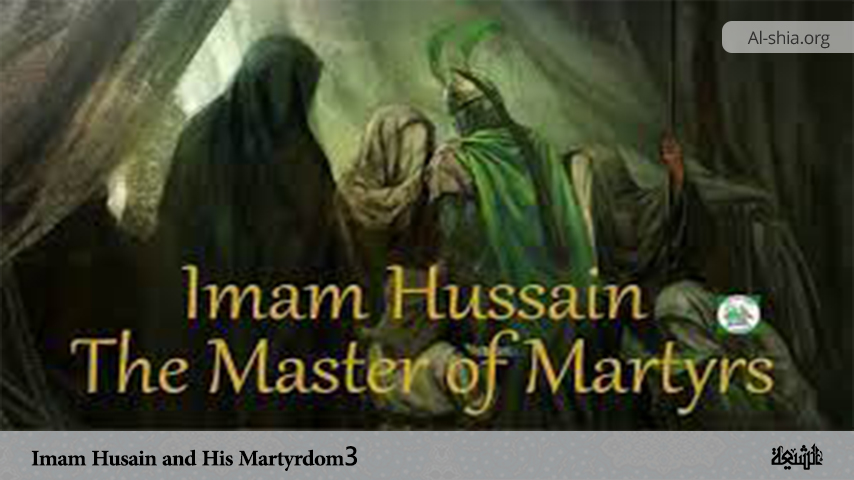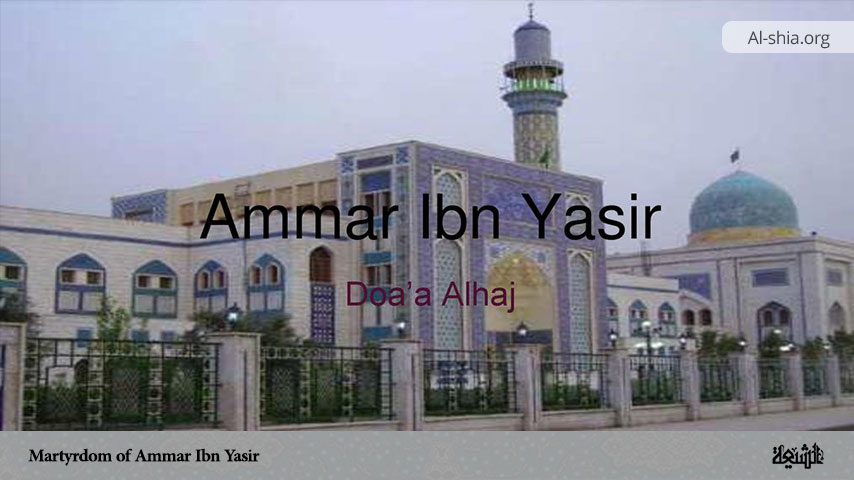In this part of the article titled “Imam Husain and his martyrdom”, we shall discuss some other relevant issues related to the martyrdom of Imam Husain (a.s).
Snare of Riches
Meanwhile, Persia came within the Muslim orbit. When Medina was captured in the year 16 of the Hijra, and the battle of Jalula broke the Persian resistance, some military booty was brought to Medina – gems, pearls, rubies, diamonds, swords of gold and silver. A great celebration was held in honour of the splendid victory and the velour of the Arab army. In the midst of the celebration, they found the Caliph of the day actually weeping. One said to him, “What! a time of joy and thou sheddest tears?” “Yes”, he said, “I foresee that the riches will become a snare, a spring of worldliness and envy, and in the end a calamity to my people.” For the Arab valued, above all, simplicity of life, the openness of character, and bravery in face of danger. Their women fought with them and shared their dangers. They were not caged creatures for the pleasures of the senses. They showed their mettle in the early fighting round the head of the Persian Gulf. When the Muslims were hard-pressed, their women turned the scale in their favour. They made their veils into flags and marched in battle array. The enemy mistook them for reinforcements and abandoned the field. Thus an impending defeat was turned into a victory.
Basra and Kufa: town-planning
In Mesopotamia, the Muslims did not base their power on old and effete Persian cities but built new outposts for themselves. The first they built was Basra at the head of the Persian Gulf, in the 17th year of the Hijra. And what a great city it became! Not great in war and conquest, not great in trade and commerce, but great in learning and culture in its best day, – alas! Also great in its spirit of faction and degeneracy in the days of its decline! But its situation and climate were not at all suited to the Arab character. It was low and moist, damp and enervating. In the same year, the Arabs built another city not far off from the Gulf and yet well suited to be a part of the desert, as Kerbela became afterwards.
This was the city of Kufa, built in the same year as Basra, but in a more bracing climate. It was the first experiment in town planning in Islam. In the centre was a square for the principal mosque. That square was adorned with shady avenues. Another square was set apart for the trafficking of the market. The streets were all laid out intersecting and their width was fixed. The main thoroughfares for such traffic as they had (we must not imagine the sort of traffic we see in Charring Cross) were made 60 feet wide; the cross streets were 30 feet wide, and even the little lanes for pedestrians were regulated to a width of 10.5 feet. Kufa became a centre of light and learning. The Khalifa Hazrat Ali lived and died there.
Rivalry and poison of Damascus
But its rival, the city of Damascus, is fattened on luxury and Byzantine magnificence. Its tinsel glory sapped the foundations of loyalty and soldierly virtues. Its poison spread through the Muslim world. Governors wanted to be kings. Pomp and selfishness, ease and idleness and dissipation grew as a canker; wines and spirituous liquors, scepticism, cynicism and social vices became so rampant that the protests of the men of God were drowned in mockery. Mecca, which was to have been a symbolic spiritual centre, was neglected or dishonoured. Damascus and Syria became centres of worldliness and arrogance which cut at the basic roots of Islam.
Husain the Righteous refused to bow to worldliness and power
We have brought the story down to the 60th year of the Hijra. Yazid assumed power in Damascus. He cared nothing for the most sacred ideals of the people. He was not even interested in the ordinary business affairs of administration. His passion was hunting, and he sought power for self-gratification. The discipline and self-abnegation, the strong faith and earnest endeavour, the freedom and sense of social equality which had been the motive forces of Islam, were divorced from power. The throne at Damascus had become a worldly throne based on the most selfish ideas of personal and family aggrandizement, instead of a spiritual office, with a sense of God-given responsibility. The decay of morals spread among the people. There was one man who could stem the tide.
That was Imam Husain. He, the grandson of the Prophet, could speak without fear, for fear was foreign to his nature. But his blameless and irreproachable life was in itself a reproach to those who had other standards. They sought to silence him, but he could not be silenced. They sought to bribe him, but he could not be bribed. They sought to waylay him and get him into their Power. What is more, they wanted him to recognize the tyranny and expressly support it. For they knew that the conscience of the people might awaken at any time, and sweep them away unless the holy man supported their cause. The holy man was prepared to die rather than surrender the principles for which he stood.
Driven from city to city
Medina was the centre of Husain’s teaching. They made Medina impossible for him. He left Medina and went to Mecca, hoping that he would be left alone. But he was not left alone. The Syrian forces invaded Mecca. The invasion was repelled, not by Husain but by other people. For Husain, though the bravest of the brave, had no army and no worldly weapons. His existence itself was an offence in the eyes of his enemies. His life was in danger, and the lives of all those nearest and dearest to him. He had friends everywhere, but they were afraid to speak out. They were not as brave as he was. But in distant Kufa, a party grew up which said: “We are disgusted with these events, and we must have Imam Husain to take asylum with us.”
So they sent and invited the Imam to leave Mecca, come to them, live in their midst, and be their honoured teacher and guide. His father’s memory was held in reverence in Kufa. The Governor of Kufa was friendly, and the people were eager to welcome him. But alas, Kufa had neither strength, courage, nor constancy. Kufa, geographically only 40 miles from Karbala, was the occasion of the tragedy of Karbala. And now Kufa is nearly gone, and Karbala remains as the lasting memorial of the martyrdom.
Invitation from Kufa
When the Kufa invitation reached the Imam, he pondered over it, weighed its possibilities, and consulted his friends. He sent over his cousin Muslim to study the situation on the spot and report to him. The report was favourable, and he decided to go. He had a strong presentiment of danger. Many of his friends in Mecca advised him against it. But could he abandon his mission when Kufa was calling for it? Was he the man to be deterred, because his enemies were laying their plots for him, at Damascus and at Kufa? At least, it was suggested, he might leave his family behind. But his family and his immediate dependents would not hear of it.
It was a united family, pre-eminent in the purity of its life and in its domestic virtues and domestic affections. If there was danger for its head, they would share it. The Imam was not going on a mere ceremonial visit. There was responsible work to do, and they must be by his side, to support him in spite of all its perils and consequences. Shallow critics scent political ambition in the Imam’s act. But would a man with political ambitions march without an army against what might be called the enemy country, scheming to get him into its power, and prepared to use all their resources, military, political and financial, against him?
Journey through the desert
Imam Husain left Mecca for Kufa with all his family including his little children. Later news from Kufa itself was disconcerting. The friendly governor had been displaced by one prepared more ruthlessly to carry out Yazid’s plans. If Husain was to go there at all, he must go there quickly, or his friends themselves would be in danger. On the other hand, Mecca itself was no less dangerous to him and his family. It was the month of September by the solar calendar, and no one would take a long desert journey in that heat, except under a sense of duty.
By the lunar calendar, it was the month of pilgrimage at Mecca. But he did not stop for the pilgrimage. He pushed on, with his family and dependents, all numbering about 90 or 100 people, men, women and children. They must have gone by forced marches through the desert. They covered 900 miles of the desert in little over three weeks. When they came within a few miles of Kufa, at the edge of the desert, they met people from Kufa. It was then that they heard of the terrible murder of Husain’s cousin Muslim, who had been sent on in advance. A poet that came by dissuaded the Imam from going further. “For,” he said epigrammatically, “the heart of the city is with thee but its sword is with thine enemies, and the issue is with God.” What was to be done? They were on three week journey from the city they had left. In the city to which they were going their own messenger had been foully murdered as well as his children. They did not know what the actual situation was then in Kufa. But they were determined not to desert their friends.
To be continued!


















